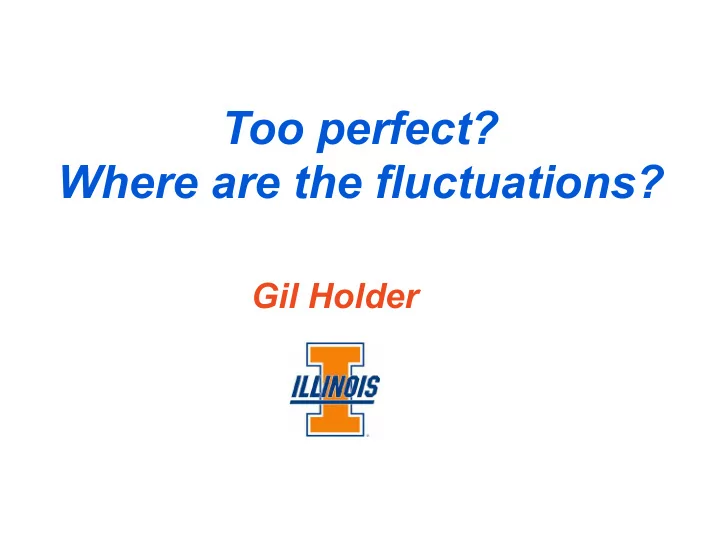

Too perfect? Where are the fluctuations? Gil Holder
Herschel (Spire) • 100 sq deg with full overlap with SPT deep field (23h30,-55d) • 250,350,500 um
Clustering of Galaxies: Projected sky maps of large scale structure have ~1-10% fluctuations • Radio and IR/submm sources presumably trace the large scale matter fluctuations • Back of the envelope: – Power spectrum contribution: mean T 2 x projected clustering amplitude – Arcminute scales: few Mpc has clustering ~1 in 3D, divide by number of independent cells along line of sight => 1e-3
CMB Angular Power Spectrum Well-fit by just 5+1 parameters: Dark energy, Dark matter, Baryon density, Initial amplitude, Power-law index+optical depth
Angular Power Spectra at mm-wavelengths • large angles Angular Scale dominated by 90 o 1 o 10 � 5 � 2 � 1 � CMB Planck SPT 220 GHz SPT - S13 SPT 150 GHz SPT 95 GHz • small scales 1000 dominated by emission from 100 galaxies – combination of shot 10 noise in galaxy number 10 500 1500 2500 6000 10000 & intrinsic clustering from large scale George et al 2015 structure
Galaxy clustering at mm/submm wavelengths • cleanly measured at many frequencies • consistent with ~10% rms fluctuations on scales of a few arcminutes Addison, Dunkley & Bond 2013
HerMES power spectra l = 21,600 l = 216 2-halo Combined 5 fields over 70 deg 2 2-halo 1-halo Poisson 1-halo Viero & Wang et al. (2012b) arXiv: 1208.5049
Planck CIB Measurements Planck collaboration 2012
Planck CIB Measurements Lenz, Hensley & Dore 1706.00011 Planck collaboration 2012
Clustering of Galaxies: Projected sky maps of large scale structure have ~1-10% fluctuations • Radio and IR/submm sources presumably trace the large scale matter fluctuations • Back of the envelope: – Power spectrum contribution: mean T 2 x projected clustering amplitude – Arcminute scales: few Mpc has clustering ~1 in 3D, divide by number of independent cells along line of sight => 1e-3
Angular Power Spectra at mm-wavelengths • large angles Angular Scale dominated by 90 o 1 o 10 � 5 � 2 � 1 � CMB Planck SPT 220 GHz SPT - S13 SPT 150 GHz SPT 95 GHz • small scales 1000 dominated by emission from 100 galaxies – combination of shot 10 noise in galaxy number 10 500 1500 2500 6000 10000 & intrinsic clustering from large scale George et al 2015 structure
CMB 20 years ago…. • possibly a peak, upper limits on small scales • typical upper limits measured in 10s of uK Bennett, Turner & White 1997 12
Upper limits ~2000 Q flat2 =5/12 l(l+1)C l /2 π μ K 2 Holzapfel et al 2000 13
Upper limits ~2000 Q flat2 =5/12 l(l+1)C l /2 π μ K 2 Holzapfel et al 2000 14
Excess radio emission at low frequencies? Fixsen et al 2011
Low-frequency CMB/Radio Background Upper Limits T-T cmb T-T cmb- T counts 16
If there is an excess, it is remarkably unclustered • minimal assumption: Planck unbiased tracer of 857 GHz 0.10 linear (2-halo) [ l ( l + 1 ) C l /2 � ] 1/2 ( � T/T) fluctuations � d Z d ⇧ 1 f � 2 P ( ↵ C � ( ↵ ) = ⇧ , ⇧ ) ⇧ 2 d ⇧ ) is the matter power spectrum at • old searches for Partridge et al 1997 CMB anisotropy VLA 8.4 GHz VLA 4.9 GHz found no evidence Fomalont et al 1988 0.01 for any fluctuations ATCA 8.7 GHz at radio wavelengths Subrahmanyan et al 2000 1 • 10 4 2 • 10 4 3 • 10 4 0 multipole l GH 2014
If there is an excess, it is remarkably unclustered • if not foreground z=[0,1] z=[0,2] Planck contamination, must z=[5,10] 857 GHz 0.10 be either [ ⇧ ( ⇧ + 1) C ⇥ / 2 � ] 1 / 2 ( ∆ T/T ) – extremely diffuse (no small scale structure on scales probed by VLA or 1 Mpc/h ATCA) 2 Mpc/h VLA 8.4 GHz – at very high redshift VLA 4.9 GHz (where intrinsic 0.01 clustering ATCA 8.7 GHz amplitudes are 1 • 10 4 2 • 10 4 3 • 10 4 0 lower) ⇧ GH 2014
Conclusions • galaxies are clustered – presumably because they are tracing dark matter, which is clustered • a background that is a superposition of a bunch of galaxies will show clustering – e.g., the cosmic infrared background shows clustering at the level of ~10% on scales of a few arcminutes • the radio background on arc minute scales is smooth at the percent level – it probably isn’t made up of a simple superposition of galaxies • unless: small-scale features are smoothed out or at high redshift so that the dark matter is relatively unclustered or coming from rare enough sources that the (small-area) radio CMB limits don’t apply 19
Recommend
More recommend